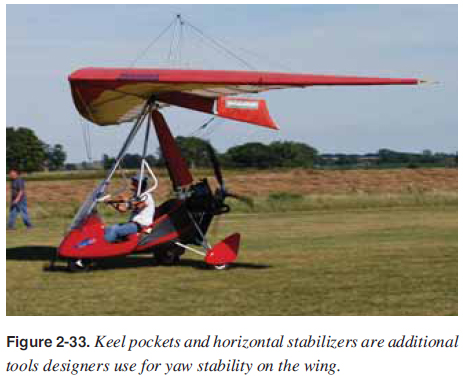
 |
|
||
CHAPTER 2. Aerodynamics Yaw Stability and Moments There is no signifi cant turning about the vertical axis because the WSC wing is designed to fl y directly into the relative wind. Any sideways skidding or yaw is automatically corrected to fl y straight with the swept wing design. An airplane uses the vertical tail to stabilize it to fl y directly into the relative wind like a dart. The unique design of the WSC aircraft performs the same function through the swept wing design, but also the wing twist and airfoil shape from root to tip assists in the correction about the vertical axis. A simple way to understand the yaw stability is to see that any yawing motion is reduced simply through the increased area of the wing as it rotates about its vertical axis. [Figure 2-32]  There is a slight amount of adverse yaw similar to an airplane that can be noticed when a roll is fi rst initiated. The amount varies with the specifi c manufacturer’s design and make/ model. In addition, the wing can yaw side to side to some degree, with some different manufacturer’s make/model more than others. The higher performance wings with less twist and a greater nose angle are noted for less yaw stability to gain performance. These wings also require more pilot input and skill to minimize yaw instability through pitch input. An addition to the wing planform, twist, and airfoil shapes to minimize yaw, some wings utilize horizontal stabilizers similar to these in airplanes and others use tip fi ns. [Figure 2-33] Generally, the WSC wing is yaw stable with minor variations that are different for each wing and can be controlled by pilot input, if needed.  Carriage Moments The wing is a signifi cant factor in the design of yaw stability, but the carriage can be a large factor also. If the area in front of the CG is greater than the area in back of the CG, and the wing yaws to the side, then the front would have more drag and create a moment to yaw the WSC aircraft further from the straight fl ight. Therefore, fi ns are sometimes put on the carriage as needed so the carriage also has a yawing aerodynamic force to track the WSC aircraft directly into the wind. [Figure 2-34]  Since the carriage has such a large effect on yaw stability, the carriage is matched to the wing for overall compatibility. Each manufacturer designs the carriage to match the wing and takes into account these unique factors of each design. Yaw Stability Summary These factors make the WSC aircraft track directly into the relative wind and eliminate the need for a rudder to make coordinated turns. Designs and methods vary with manufacturer and wing type, but all WSC wings are designed to track directly into the relative wind. |
| ©AvStop Online Magazine Contact Us Return To Books |